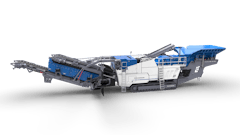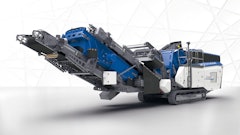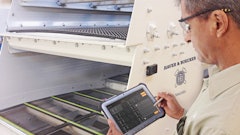
Arnold Crushed Stone, Inc. knew they had to increase production 125% and reduce costs at its two Texas limestone quarries to take full advantage of new oil field market opportunities for crushed and sized aggregates, meet existing customers' growing requirements, offer competitive pricing, and still make an acceptable profit. They felt the solution would hinge on three main factors: 1) More efficient crushing and screening, with sturdy machines that are simple to operate and easy to maintain; 2) Tracked equipment in addition to their current stagnant (stationary) crushing/screening plant; 3) The continued efforts of their production staff to achieve increasingly efficient operations. The company is headquartered at the Blum quarry and has been in business since 1968.
Arnold's quarries located in Johnson County at Blum and Tolar, Texas, about 50 miles from Fort Worth, produces basically three product categories: 1) Flex base 1 3/4-inch stone to meet state specifications; 2) Sized products such as 8- to 12-inch, 12 to18-inch and 18- to 24-inch rip-rap and gabion, which is a 4- to 8-inch material used for erosion control and backing for retaining walls; 3) Other products for oil field (natural gas well) applications, such as drill rig pads, roads and general construction. The growing oil field demands offered Arnold their greatest opportunities-and challenges.
The Barnett Shale field is a natural gas pocket where drilling began about ten years ago in Denton and Wise counties, which border on Arnold's Blum quarry area in Johnson County. As the Barnett project expanded into Johnson County, Arnold Crushed Stone sales were growing dramatically.
"To keep up with demand we would have to make some major changes," says Arnold Operations Manager, J. Miles Arnold. "We did have one big advantage right off the bat, though, and that's our staff-headed up by plant managers Larry Freeman, Sr. at Blum, and Larry "Chopper" Freeman, Jr. at Tolar. I really do believe we have the best crews in the state-and maybe the whole United States. They're knowledgeable, hard working, dedicated people who are always looking for ways to better our facilities and procedures. We figured if we could give our crews the latest and best equipment we could find, we'd be able to meet any current and future production needs."
Arnold also decided they had to go to tracked equipment in addition to the stationary crusher/screen plant they had at Blum. The company had no crushing/screening equipment at Tolar at that time. A "track strategy" would enable Arnold to follow the quarry face with crushing and screening plants and have customers' trucks come right down onto the quarry floor to pick up their stone. That would cut down on labor time, loaders and haul trucks to take shot stone to the current crushing-screening-loading area at Blum.
For its Blum quarry, Arnold evaluated four manufacturers' tracked crushing and screening equipment - as well as dealer support, which they felt would be crucial.
"Our people are specialists in production, not maintenance and repair," Arnold explains. "So we need equipment that's extremely dependable and easy to service. But we also need a dealer who is attentive, knowledgeable and ready to help us solve problems and meet objectives. We found Powerscreen Texas to be the answer.
"After lengthy discussions of our operation and objectives with Seamus 'Sam' McNabb, our Powerscreen Texas representative, we brought in a tracked TEREX PEGSON 1412 Trakpactor impact crusher and tracked Powerscreen Chieftain 1400 dry screen on demo 18 months ago at Blum. It took us all of 20 minutes to see that these machines were everything Sam had promised. We bought both machines on the spot and sent Powerscreen Texas a check the next day. In fact, we've been so satisfied that we bought a second 1412 Trakpactor and Chieftain 1400 a year later for our Tolar quarry.
Arnold uses four high chrome blow bars in the TEREX PEGSON 1412, which employs a Hazemag AP-PH 1214Q primary impact crusher. After 12 and six months of use respectively at Blum and Tolar, there has not been enough wear to require replacing or turning any blow bars. Arnold did, however, practice turning blow bars to see how long it would take: 1-3/4 hours versus 2-1/2 days on their stationary crushing plant.
The new 1412 Trakpactor and Chieftain 1400 combinations at Blum and Tolar are each providing a 45% increase in production at 30% less cost per ton compared to the existing stationary crushing equipment still in use at Blum. Further, the new tracked crushing strategy has eliminated the need for three haul trucks and one front-end loader. And all the crushing and screening operations together have increased Arnold Crushed Stone's production by the 125% needed to meet all market demands and take on new customers. This has made Arnold the largest independent producer of crushed stone in North Texas, the largest provider to Johnson County, and one of the largest in the entire Lone Star State.
"I believe we will be able to produce even more crushed and sized stone as the need arises," Arnold exclaims. "Wells are being drilled at a rate of one for each 40 acres. There are about 150 rigs in the area so far. We have the crews, the efficient crushing/screening equipment and the dealer backup to supply the market's needs. We operate one shift six days a week. And we're actually out-producing other companies around here that run two shifts.
"We run as much limestone through our system as possible without worrying about overloading the impactor. The CANBAR computer digital readout tells us the condition of the machine at all times, and it correlates the rotor and engine speeds with the feeder to make them all work in unison.
"If the crusher is getting too much material, the system alerts itself to speed up the engine and slow down the feeder. This eliminates having a man standing on top looking at the input and making engine and feeder adjustments based on guesswork. That is a very major advantage.
"Another big advantage is dealer support. I think it's one thing a lot of people don't realize when they buy equipment. Let me give you some examples …
"I can call Sam McNabb any time to discuss just about any aspect of our quarry operation, whether it pertains directly to Pegson and Powerscreen equipment or not. He and the others at Powerscreen Texas know their business and mine. Sam will be here at the drop of a hat if I need him in hurry.
"A good dealer can give you valuable counsel and will actually listen to your ideas, as well. We told Sam we'd like to have hydraulic rams instead of tensioning bolts on the Chieftain 1400, which would drastically reduce the time to change screens. Sam discussed it with the chief engineer at the factory, and our 1400s were delivered with rams."
McNabb adds: "Actually Powerscreen-Pegson dealers are in touch with the factory on a pretty regular basis to keep them appraised of customers' ideas and situations so equipment can be designed or altered to give the market exactly what it wants and needs in equipment design, features, maintenance and so on. It's one of our strong selling points.
"Customers like Miles Arnold tell us they really value and appreciate that kind of input opportunity and feedback results," McNabb says. "Recently, for example, due to customer input, the factory raised the hopper walls 12 inches higher on the Powerscreen Chieftain 1400 to more fully utilize the screen's production capacity. That's one of the new features that make it the ideal machine for Arnold Crushed Stone."
The Powerscreen Chieftain 1400 dry screen can produce more than 400 tons per hour, depending on mesh sizes and material, and features a patented four-bearing screen box, hydraulic folding conveyors, hydraulic screen angle adjustment, and integrated high-capacity/variable speed belt feeder. Also standard are a radio controlled tipping grid, screen walkway and access ladder, and engine shut-down system. The unit is fully CE approved.
Options include a single or double-deck vibrating grizzly, a shredder, hydraulic screen tensioning, radio-controlled tracking, 12- or 14-foot hopper, and hydraulic jacking legs. Available as wheel-mounted or tracked chassis with optional wheeled bogie for transport.
The TEREX PEGSON 1412 Trakpactor features a Hazemag horizontal AP-PH 1214Q primary impact crusher with a 32- by 54-inch feed opening, hydraulic apron locking mechanism with overload protection and automatic reset, and the latest PLC CANBUS control system. The crusher opens and adjusts hydraulically. The 48-inch dual-drive discharge conveyor raises and lowers hydraulically.
Arnold Crushed Stone was founded in 1968 by Miles' grandfather, Corky Arnold. Corky was in real estate and knew nothing about aggregates production. But he saw a future in the business and was a courageous doer who took the risks and learned quickly. Later he was joined by Miles' father, Mike Arnold, now president, who continued and advanced the Arnold philosophy of "being the best in the business." Miles says he just grew up in the business, working at this and that, and fell in love with it. Miles joined the company officially as operations manager after graduating from college. "We've always worked hard to give our customers absolute quality and satisfaction," he says. "Because our good name is on the line with every single transaction."













![Ec 8x20 Screen Plant 7x3 300dpi Cmyk[92]](https://img.forconstructionpros.com/files/base/acbm/fcp/image/2023/02/Ec_8x20_Screen_Plant_7x3_300dpi_CMYK_92_.63e65b2f9c33e.png?auto=format%2Ccompress&fit=crop&h=135&q=70&w=240)













